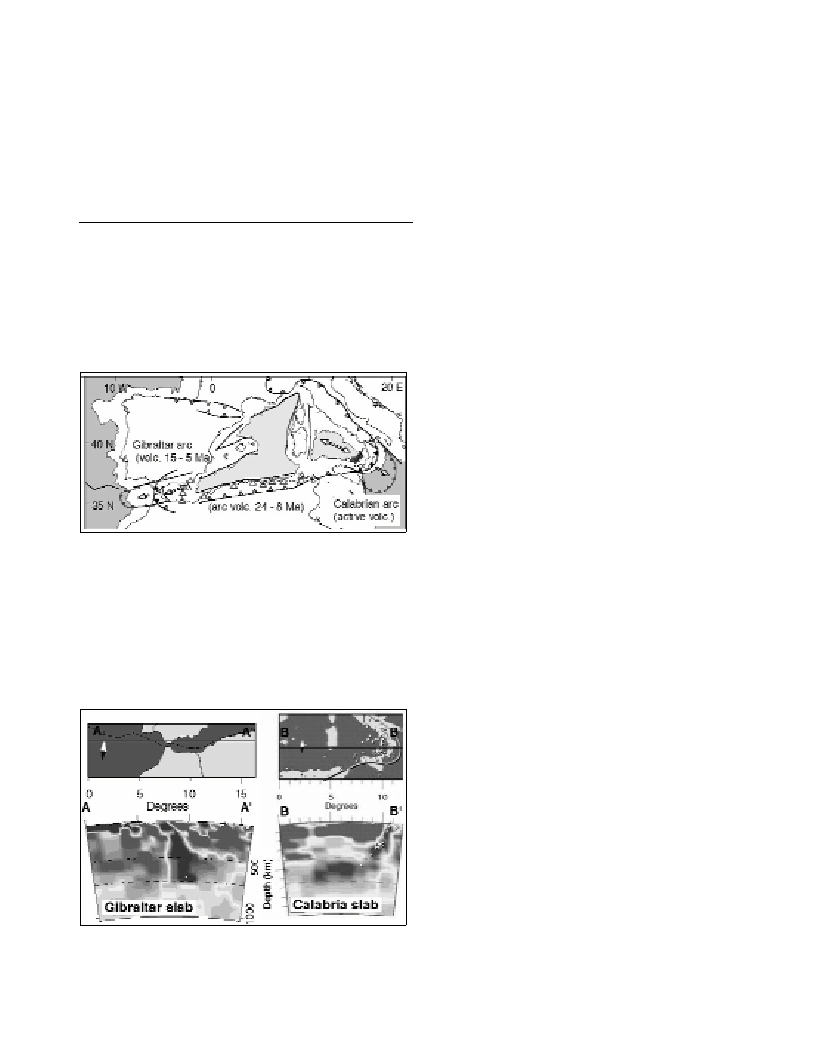SUBDUCTION SYTEMS IN THE WESTERN MEDITERRANEAN :
ASSESSING THE ACTIVITY AND SEISMIC RISK
M.-A. Gutscher, E. Thiebot
*
, J.-P. Rehault
IUEM, UMR 6538, Domaines Océaniques, Plouzané, France - gutscher@univ-brest.fr
Abstract
Geophysical and geochemical data indicate the presence of slabs of oceanic lithosphere, with recent subduction beneath the Gibraltar and
Calabrian arc systems. Great historical earthquakes and tsunamis have been recorded in these regions, whose source remain unkown. We
propose that subduction beneath Gibraltar and Calabria is active and that a large, locked seismogenic zone exists. Acqusition of additional
data is required to test this hypothesis.
Key words: subduction, earthquake, tsunami, Gibraltar, Calabria
Rapp. Comm. int. Mer Médit., 37,2004
36
The Western Mediterranean (from S Iberia to S Italy) is the site of
slow convergence between Africa and the southwest ?ank of Europe.
Here, several Neogene basins situated on the interior of Alpine fold-
and-thrust belts appear to have undergone extension and subsidence
during active orogenic convergence [1,2]. The Western Mediterranean
region is bounded at its extremities by two small subduction systems,
with accompanying back-arc basins: the Gibraltar arc – Alboran Sea to
the west and the Calabrian arc – SE Tyrrhenian Sea, to the east (Fig.1).
Arc volcanism occurs presently behind the Calabrian slab (the Aeolian
Islands), but ceased in the W Alboran Sea around 5 Ma [3].
Fig.1. Geodynamic setting of the Western Mediterranean with the
Gibraltar and Calabria subduction – arc systems indicated. Note the cur-
rent volcanic arc in the SE Tyrrhenian Sea and the paleo-arc in the W.
Alboran Sea.
Tomographic image reveal high p-wave velocity anomalies (cold,
dense slabs of oceanic lithosphere) extending continuously from
oceanic domains at the surface down to the 660 km discontinuity, and
passing through regions of intermediate and deep focus seismicity
[4,5] (Fig. 2). The regional kinematics and back-arc basin formation
are best explained by models of slab-roll back during subduction
[1,5,6] The question which remains is; are these subduction systems
still active today?
Fig. 2. Seismic tomographic images A: cross-section at 36°N across the
Gibraltar Arc, B: cross-section through Calabria and Sardinia.
The Gibraltar and Calabria regions are marked by a moderately
high degree of seismicity, but have been the site of devastating
historical earthquakes. In particular, the sources of the great “Lisbon”
earthquake of 1755 and the Catania earthquake of 1693 (which each
caused upwards of 60,000 casualties), remain unknown to this day
[7,8]. However, the generation of strong tsunamis (>5 m wave
heights) implies a source region at least partly at sea. No
instrumentally recorded subduction interface earthquakes (with a
shallow-dipping, thrust-type focal mechanism) are known for either of
these two sytems. Therefore, either subduction has ceased (no
seismogenic zone), subduction is active and aseismic, or subduction is
active and the seismogenic zone is currently locked. We favor the
latter interpretation, in which case the two arcs would exhibit a similar
behavior as the Nankai or Cascadia subduction zones, characterized
by a large locked zone, and a recurrence time of 100 – 1000 years for
great earthquakes.
The active subduction hypothesis requires testing and we propose
the following criteria to determine the activity of the Gibraltar and
Calabria subduction systems:
- active thrusting at the deformation front of the accretionary wedge
- active extension in the back-arc domain (subsidence or sea-?oor
spreading)
- great earthquakes with long recurrence interval
- independant kinematics of the upper plate block (Gibraltar /
Calabria)
- active lateral bounding faults (likely with transcurrent motion)
A series of marine geophysical cruises are planned for 2003 – 2005
to constrain deformation in the Gulf of Cadiz accretionary wedge and
the turbidite record in the adjacent abyssal plains.
References
1-Rehault, J.-P., Boillot, G., Mauffret, A., 1985, The western
Mediterranean Basin. Pp. 101-129. In: D.J. Stanley, and F.C. Wezel (eds.),
Geological Evolution of the Mediterranean Basin. Springer, Berlin,
2-Malinverno, A., Ryan, W.B., 1986. Extension in the Tyrrhenian Sea and
shortening in the Appenines as a result of arc migration driven by sinking
of the lithosphere. Tectonics, v. 5: 227-245.
3-Duggen, S., Hoernle, K., van den Bogaard, P., Ruepke, L., Phipps-
Morgan, J., 2003, Deep roots of the Messinian Salinity Crisis. Nature,
402: 602-606.
4. Wortel, M.J.R., Spakman, W., 2000, Subduction and slab detachment in
the Mediterranean-Carpathian region. Science, 290: 1910-1917.
5-Gutscher, M.-A., Malod, J., Rehault, J.-P., Contrucci, I., Klingelhoefer,
F., Mendes-Victor, L., Spakman, W., 2002. Evidence for active subduction
beneath Gibraltar. Geology, 30: 1071-1074.
6-Gvirtzman, Z., and Nur, A., 1999. The formation of Mount Etna as the
consequence of slab rollback. Nature, 401: 782-785.
7-Baptista, M.A., Miranda P.M.A., Miranda, J.M., Mendes Victor, L.,
1998. Constraints on the source of the 1755 Lisbon tsunami inferred from
numerical modelling of historical data on the source of the 1755 Lisbon
tsunami. J. Geodynamics, 25: 159-174.
8-Piatenesi, A., and Tinti, S., 1998. A revision of the 1693 Sicily
earthquake and tsunami.J. Geophys. Res., 103: 2749-2758.

